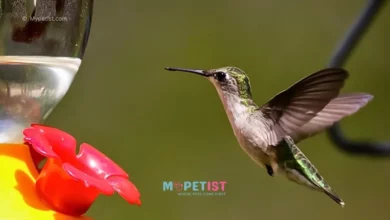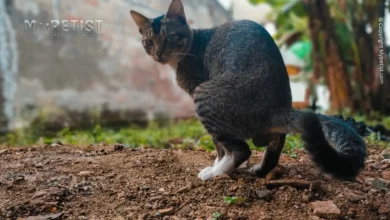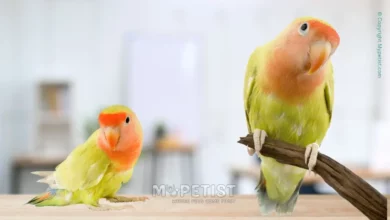12 Tips on How To Train A Parrot To Talk
Teaching your pet parrot to talk can be a rewarding experience for both you and your feathered friend. Training a parrot to talk can be a challenging, yet rewarding experience. In this article, we will provide you with 12 essential tips on how to train a parrot to talk. From understanding their vocal abilities to using positive reinforcement techniques, these tips will help you get your parrot talking in no time.
It takes patience and consistency to teach a parrot the basics of speech, but with the right approach and guidance, you’ll soon have your feathered friend chirping away! Whether you want your parrot to greet you with a cheerful “hello” or to tell you how much they love you, these tips will help you make progress in teaching your pet parrot to talk.
Table of Contents
- The benefits of having a talking parrot as a pet
- Understanding your Parrot’s Nature
- How this translates to their behavior in captivity
- Why understanding your parrot’s personality and preferences Is important
- 12 Tips on How To Train A Parrot To Talk
- Tip #1. Start with Basic Commands
- Tip #2. Encourage Vocalization
- Tip #3. Repeat and Reinforce
- Tip #4. Use a Variety of Voices To Teach A Parrot To Talk
- Tip #5. Always Be Patient:
- Tip #6. Spend Quality Time with Your Parrot
- Tip #7. Socialization and playtime can enhance your parrot’s ability to learn and communicate
- Tip #8. Teach Your Parrot to Respond to Your Voice
- Tip #9. Introduce New Phrases Gradually
- Tip #10. Gradually increasing the complexity of your parrot’s vocabulary
- Tip #11. Create a Positive Learning Environment
- Tip #12. Tips for making your parrot feel safe and secure during training
- All In All
The benefits of having a talking parrot as a pet
Having a talking parrot as a pet can be a fantastic experience. It is like having a pet that can communicate with you in human speech. This pet bird has the unique ability among all other birds to talk and can be trained to say the word and phrases. For most pet owners, a talking parrot is a source of amusement and entertainment.
They can learn simple words, mimic various sounds and entertain their owners with their unique abilities. Moreover, talking parrots can help owners to connect with their pets. They can develop a sense of attachment to their owners, who talk to them regularly.
In addition to entertainment, a talking bird can also be beneficial for people who are struggling with anxiety or depression, as parrots are known to be emotionally intelligent creatures. Overall, a talking parrot can be an excellent addition to any home as a source of companionship and amusement.
Understanding your Parrot’s Nature
how parrots communicate in the wild
Parrots are known for their impressive communication skills, both in captivity and in the wild. In the wild, parrots use a variety of cues to communicate with each other. One of the most common ways they communicate is through vocalizations. Parrots have a large repertoire of calls, songs, and whistles, which they use to mark territories, attract mates, and warn of potential threats. They can also mimic the calls of other birds and animals, which can be used to confuse predators.
Parrots also use body language to communicate. They can communicate their intentions through gestures such as head tilts, wing flutters, and beak clicking. They can also use their bodies to display dominance or submission. For example, spreading their wings and puffing up their feathers can signal aggression, while crouching down and lowering their head can signal submission.
Finally, parrots use visual cues to communicate with each other. They can use their colorful plumage to signal their identity, status, and emotional state. Their eyes and pupils can also signal emotions such as fear, anger, or excitement. Overall, parrots have a complex and sophisticated system of communication that helps them thrive in the wild.
How this translates to their behavior in captivity
Parrots are intelligent and social animals that thrive in their natural habitat. However, when kept in captivity, they can manifest various behavioral issues due to the lack of stimulation and poor living conditions. Parrots require plenty of social interaction, physical activity, and mental stimulation to lead a healthy life.
Without these, they can become bored, frustrated, and may show aggressive behavior such as biting, screaming, and feather plucking. To prevent these problems, parrots in captivity must be provided with numerous opportunities to engage in natural behaviors like foraging, climbing, and socializing. They also need a large living space, toys to play with, and a healthy diet.
It is essential to understand the natural behavior of parrots and provide them with an environment that meets their physical, social, and mental needs to ensure they are happy and healthy in captivity.
Why understanding your parrot’s personality and preferences Is important
Understanding your parrot’s personality and preferences is crucial when teaching them to talk. Every bird has its own unique character and learning style. For instance, some parrots are naturally more vocal and will readily mimic sounds and words, while others may be more hesitant, timid or stubborn.
The first step in training your parrot to talk is to establish a strong bond of trust and respect with your feathered friend. This involves spending quality time with your parrot, providing them with enrichment and interacting with them in a positive and reinforcing way.
Once you have a good relationship with your bird, you can begin to work on their vocalization skills by using positive reinforcement and reward-based training methods. It’s also important to be patient, consistent, and to work at your bird’s own pace. With time and practice, you and your parrot can develop a wonderful bond based on effective communication and mutual understanding.
12 Tips on How To Train A Parrot To Talk
Learn how to effectively train your pet parrot to talk with these 12 easy tips! Everything you need to know in one place to have your parrot talking in no time.
Tip #1. Start with Basic Commands
Simple phrases that are easy for parrots to learn
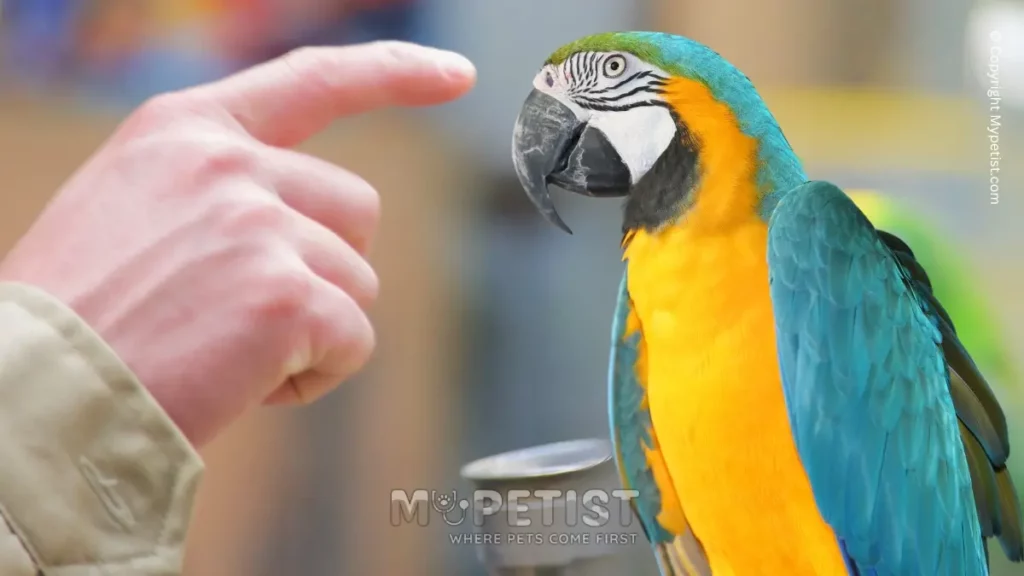
Parrots are well-known for their ability to mimic human speech and various sounds. However, not all phrases are equally easy for parrots to learn. Some phrases are more complex and require more practice, while others are simple and straightforward. Some of the most common simple phrases that are easy for parrots to learn include: “hello,” “goodbye,” “thank you,” “I love you,” “what’s up,” and “how are you.” These phrases are short, clear, and often repeated, which makes them perfect for parrots to pick up quickly.
Additionally, parrots may also learn common sounds like whistles, clicks, and various animal noises relatively easily. However, it’s important to note that every parrot is unique, and some birds may find certain phrases or sounds easier or more challenging to learn. Regular practice and positive reinforcement are key to teaching parrots new phrases and sounds.
How repetition and consistency are key to teaching parrots to speak
Repetition and consistency play an essential role in teaching parrots to speak. Parrots are intelligent birds and mimicry comes naturally to them. However, it is not enough to just play a recording of a phrase over and over for the bird to learn it. Repetition is crucial in teaching because it reinforces the words and phrases that the bird is learning, which helps to solidify their understanding.
Additionally, consistent reinforcement of what has been learned is necessary for the words and phrases to stick. Daily practice sessions and frequent use of the words in the bird’s environment will keep the language fresh in its mind. Patience is key when teaching a parrot to speak, as some birds can take weeks or months to master a single phrase. With consistent repetition and a positive reinforcement approach, parrots can learn to speak with clarity and proficiency.
Using positive reinforcement to reward your parrot’s progress
Positive reinforcement is an effective way to encourage your parrot’s good behavior and progress. The use of treats, praise, and attention can all serve as positive reinforcements for your bird. When rewarding your parrot, it’s important to be consistent and timely. Reinforce their desired behavior immediately after it’s displayed, and use the same reinforcement consistently.
Try to mix up types of rewards to keep your bird motivated and interested. Set small, achievable goals in training to keep your parrot encouraged and constantly learning. Lastly, make sure to maintain a positive attitude throughout the training process, as parrots are incredibly intuitive animals that pick up on emotions easily. With these tips, you can build a strong bond with your parrot while encouraging their good behavior.
Tip #2. Encourage Vocalization
How parrots learn by mimicking and how their vocal cords work
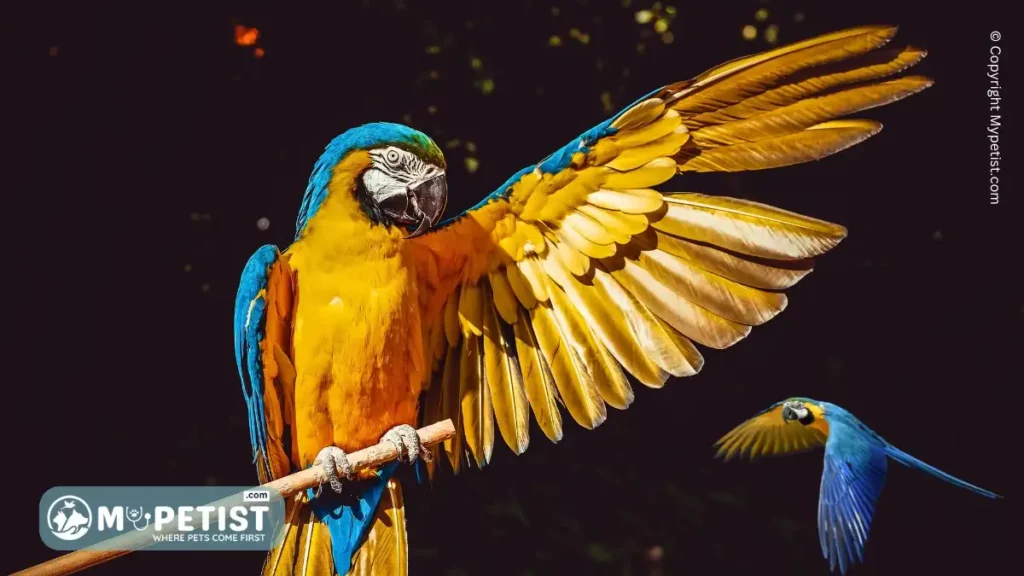
Parrots are known for their incredible ability to mimic sounds, including human speech. They have a unique vocal organ, called the syrinx, which allows them to produce a wide range of sounds. Parrots learn to mimic through a process of repetition and reinforcement.
By consistently hearing and repeating a particular sound, their brains begin to associate that sound with a specific action or object. This is a form of conditioning, and over time, the bird will start to produce the sound on its own. As a responsible pet owner, it is important to train your bird and help teach your parrot new words or phrases.
Consistency is key when trying to help your bird learn, and using positive reinforcement techniques such as treats or praise can be very effective. It may take some time, but with patience and practice, you can eventually help teach your bird to say almost any word or phrase!
Activities that encourage your parrot to vocalize, such as singing, whistling, and playing music
Parrots are known for their chatty and vocal nature, and as pet owners, it is our responsibility to encourage and stimulate their vocalizations. Singing, whistling, and playing music are some of the best activities that we can provide for our feathered friends to keep them active and happy. In addition, dance, mimicry, and talking games are other activities to promote vocalization.
Playing recorded songs or natural sounds of the outdoors can keep them entertained for hours. Talking to them regularly can also help them learn new words or phrases. Providing them with toys that make sounds can also encourage playing and exercising. It is essential to give them ample opportunities to make noise, as it not only keeps them busy and happy, but also enhances their cognitive and communicative abilities. However, it is equally important to ensure not to disturb their rest times or annoy the neighbors with loud sounds.
How to create a comfortable environment that promotes vocalization
Creating a comfortable environment that promotes vocalization is essential, especially for those who have communication difficulties. The first step is setting up a safe and secure space that allows individuals to feel at ease. This can be achieved by choosing a quiet, dimly lit setting, free from distractions or overwhelming sensory stimuli.
Good lighting can also help with lip-reading, and reduce the chance of visual stress. Additionally, using cushions, blankets, or soft furnishings can make a space cozier and more inviting. Communication aids and devices should also be on hand and easily accessible. It can encourage individuals to try out different types of communication methods that they might not have considered before.
Finally, use positive language in your interactions and provide support and encouragement for others to express themselves. By creating such an environment, individuals are more likely to feel confident and at ease.
Tip #3. Repeat and Reinforce
How consistency and repetition are essential
Consistency and repetition are crucial when training your parrot to speak. Parrots are intelligent creatures, and they require consistent effort and repetition in order to properly learn new words and phrases. It’s important to consistently reinforce the words and phrases you want your bird to learn. The more you repeat the words and phrases, the more your bird will understand and learn. Additionally, you should use the same tone and inflection each time you speak to your bird.
By using the same tone of voice, your parrot will begin to recognize and associate certain sounds with specific words and phrases. Remember that patience is key when teaching your parrot to talk. It may take weeks or even months of consistent practice for your bird to truly grasp and repeat new words and phrases. So, keep practicing and be consistent in your efforts to teach your feathered friend to speak.
Provide strategies for reinforcing good behavior
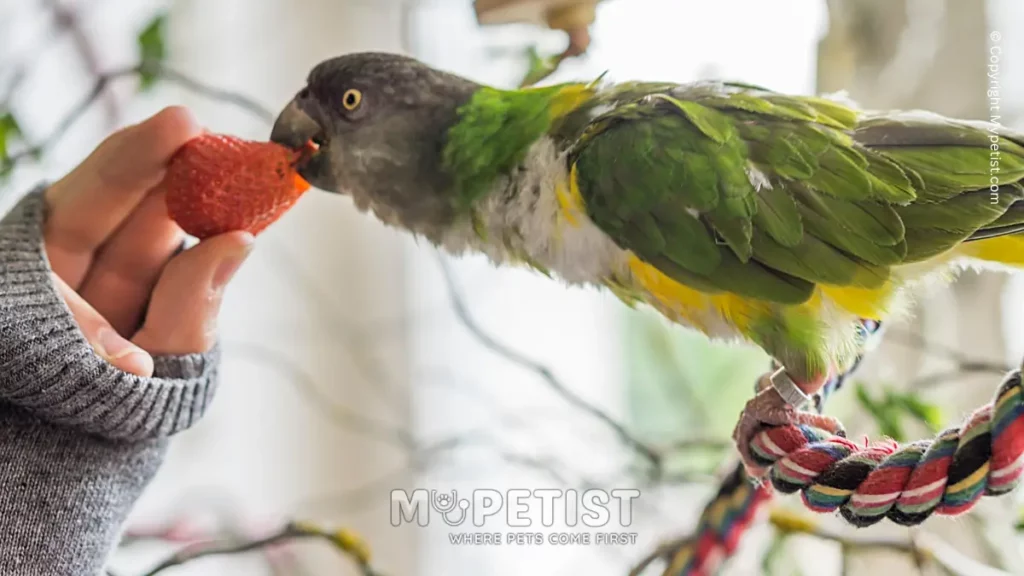
Reinforcing good behavior through positive reinforcement and treats is an effective way to encourage desirable behavior in children, pets, or even yourself. Positive reinforcement involves rewarding good behavior with praise, attention, or tangible rewards like treats or privileges.
Treats can be an excellent way to reinforce positive behavior, but it is essential to keep them in moderation and not overuse them. It is crucial to be consistent in applying positive reinforcement and treats, using them only for worthy behavior and not rewarding mediocrity.
Additionally, it is helpful to establish clear expectations and rules, ensuring that the desired behavior is explicit and understood. Overall, using positive reinforcement and treats to promote good behavior is a win-win situation, as it encourages desirable behavior while also strengthening the bond between the giver and the receiver.
Tip #4. Use a Variety of Voices To Teach A Parrot To Talk
Varying your voice can be an effective way to train your parrot to recognize different sounds and intonations. By using different tones and pitches, you can help your parrot distinguish between commands, expressions of affection, and warnings. Speaking gently and softly signals that it’s a good time to interact with the bird, whereas using a sharp, loud tone indicates something is wrong, and the bird should be cautious.
You can also try singing and whistling different tunes to keep your parrot engaged and interested. These variations in sound can help your bird develop its listening and memory skills while building trust with you. Consistent training with a variety of sounds can help your parrot become more responsive and attuned to you, ultimately strengthening your bond with your feathered friend.
Encourage using different voices for different activities
It is important to encourage using different voices for different activities in children. For example, using a playful voice during playtime can add excitement and engagement to the activity. It can make children feel more comfortable and enthusiastic to participate in games and activities.
Additionally, using a soothing voice during bedtime can create a calm and relaxing environment that promotes sleep. Children’s brains respond to the tone of voice, so using a soothing voice while reading bedtime stories can help them feel safe and secure, making it easier for them to fall asleep.
Teaching children to differentiate between different types of voice will help them develop strong communication and social skills that will benefit them in the future. It is essential to create an environment that encourages vocal expression and helps children grow in various facets of their lives.
Tip #5. Always Be Patient:
Teaching your parrot to talk takes time and patience
Teaching your parrot to talk takes a lot of time and patience. It’s not something that can be achieved overnight, and it requires consistent effort on your part. Parrots are intelligent birds that can learn different words and phrases quite easily, but they need constant repetition and encouragement. You can start by teaching your parrot simple words like “hello” or “goodbye”, and gradually move on to more complex phrases.
It’s important to understand that not all parrots will learn to talk, and some may learn faster than others. The key to success is to be patient, consistent, and always reward your parrot for its efforts. With time and effort, you will eventually be able to communicate with your parrot in a meaningful way, and have a wonderful bond that will last a lifetime.
Tips for dealing with setbacks throughout the training process
Dealing with setbacks during the training process can be challenging, but it’s important to stay motivated and persevere to achieve your goals. One tip is to focus on the progress that has been made, rather than the setbacks. Celebrate small accomplishments along the way to help keep the motivation going.
Another tip is to find a support system to rely on when times get tough – this could be a coach, training partner, or even online communities. Staying accountable to others can help keep you on track and motivated. It’s also important to listen to your body and take rest days when necessary to prevent burnout or injury.
Finally, try to stay positive and remind yourself of the reasons why you started training in the first place. A positive attitude can help you push through setbacks and achieve your goals.
Tip #6. Spend Quality Time with Your Parrot
The importance of spending quality time
Spending quality time with your parrot is crucial for establishing a strong bond and achieving successful training outcomes. It is important to schedule regular training sessions with your bird and dedicate uninterrupted time to focus on the training.
Whether you are teaching your parrot to talk, perform tricks or socialize with people and other birds, consistency and patience are key. In addition, spending quality time with your parrot outside of training sessions is equally important. This includes interacting with your bird, providing plenty of toys and puzzles for enrichment, and creating a comfortable and stimulating environment.
By investing time and effort into your relationship with your parrot, you will not only enjoy a happier and healthier bird, but also a lifelong companion that will bring joy and entertainment to your life.
Tip #7. Socialization and playtime can enhance your parrot’s ability to learn and communicate
Socialization and playtime are crucial aspects of a parrot’s development and learning process. Through socialization, parrots learn to interact with humans and other birds, which can aid in their communication skills. Playtime, on the other hand, provides mental stimulation and physical activity, which can help develop a bird’s cognitive abilities. Parrots that are well-socialized and engage in regular playtime are more apt to mimic speech, learn new behaviors, and communicate with their owners.
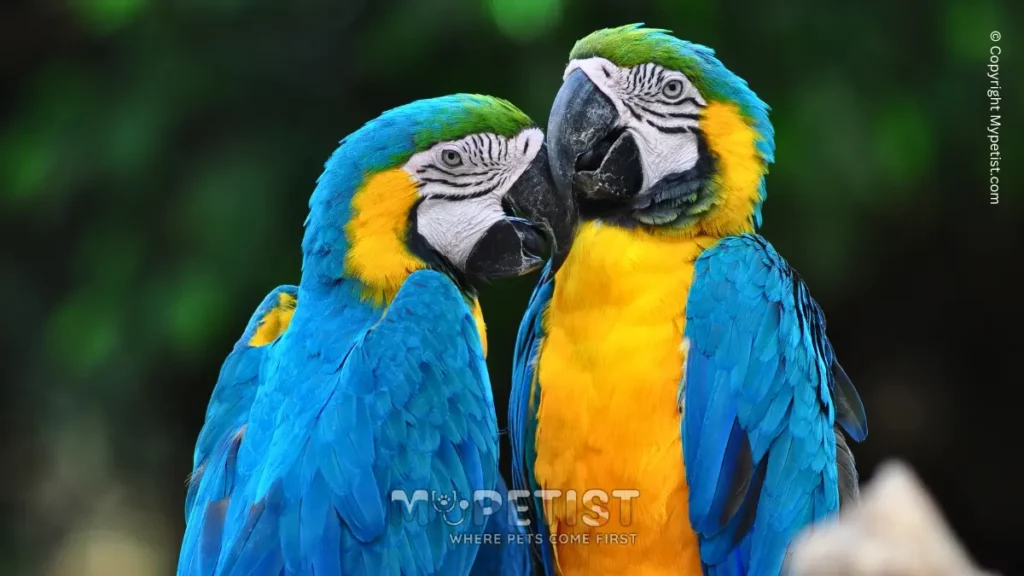
Additionally, interactive games such as puzzles and training exercises can challenge a parrot’s problem-solving abilities, further enhancing their cognitive function. As such, socialization and playtime are essential components of any parrot’s learning and development, and owners should ensure their feathered friends have ample opportunities to engage in both.
Tip #8. Teach Your Parrot to Respond to Your Voice
Conditioning your parrot to your voice
Conditioning your parrot to your voice can be highly beneficial when it comes to teaching them how to talk. Parrots have the ability to mimic sounds and human speech, and by familiarizing them with your voice, they are more likely to learn from you.
Repeating particular phrases to your parrot consistently can have an impact on their learning, and they will recognize the sounds and tones of your voice. This can help speed up the learning process as they will associate your voice with something positive and reinforcing.
Consistency is key when it comes to training your parrot to talk, so it is essential to spend plenty of time with them and repeat the phrases you wish for them to learn frequently. With patience and perseverance, conditioning your parrot to your voice can be an effective way to encourage them to start speaking.
Tips for creating a positive association between your voice and food, play, or other pleasant stimuli
Creating a positive association between our voice and pleasant stimuli such as food or play can be a great way to strengthen our relationships and improve communication with pets or children. One effective tip is to use a high-pitched and expressive tone when giving praise, praise cues, or instructions. This can signal to the recipient that something good is going to happen when they hear that tone, and can make them more responsive and engaged.
Another tip is to always pair our voice with positive physical gestures or actions, such as petting or offering treats. This can create a consistent positive experience for our pets or children, and help them associate our voice with happiness and rewards. Finally, it’s important to be consistent and patient when using these techniques, as it may take time for the association between our voice and pleasant stimuli to become established.
Tip #9. Introduce New Phrases Gradually
Introducing new phrases slowly can be beneficial in helping your parrot retain what they have learned. If too many new words are introduced too quickly, it can overwhelm the parrot and cause them to forget what they have learned previously.
It is important to gauge the parrot’s level of comprehension and to work at a pace that is comfortable for them. When introducing new phrases, it’s best to start with simple words and commands and then gradually add more complex phrases. Repetition is also key in helping your parrot remember what they have learned, so it’s important to frequently repeat the new phrases to solidify them in their memory.
Additionally, it’s important to consistently use the same words and commands, so the parrot can associate them with specific behaviors or actions. With patience and consistency, introducing new phrases slowly and steadily can help your parrot retain what they have learned and continue to build on their vocabulary.
Tip #10. Gradually increasing the complexity of your parrot’s vocabulary
Teaching your parrot new words can be a fun and rewarding experience, but it’s important to do it in a way that doesn’t overwhelm your feathered friend. One tip is to start with simple and easy-to-understand words such as their name, basic commands like “step up” or “good bird,” and common phrases like “hello” or “peekaboo.” Once your parrot has mastered these words, gradually increase the complexity of the words and phrases you teach them.
Another tip is to vary the words you teach them to keep them engaged and interested. Providing positive reinforcement in the form of praise or treats when they correctly say a new word will encourage them to continue learning. It’s also important to avoid pressuring your parrot to speak or getting frustrated if they don’t learn a word right away. With patience, consistency, and a gradual approach, your parrot will expand its vocabulary in no time!
Tip #11. Create a Positive Learning Environment
When training a parrot to talk, creating a positive learning environment is crucial. Parrots are intelligent birds, and it is for this reason that they make excellent talking pets. However, this intelligence also means that they are easily influenced by their surroundings. Therefore, it is essential to create an environment that is conducive to learning. One way to establish this is to reward your parrot with treats every time they successfully mimic a word or phrase.
The act of providing positive reinforcement motivates them to persist in their pursuit of learning. Additionally, setting up a designated training area that is calm and free of distractions, such as noise or other animals, can help keep your parrot focused and motivated. A positive learning environment can significantly impact your parrot’s ability to talk and thrive, leading to a happier and healthier relationship between you and your feathered friend.
Tip #12. Tips for making your parrot feel safe and secure during training
Parrots are intelligent and sensitive creatures who require positive reinforcement training methods to feel safe and secure. One of the most significant tips for making your parrot feel safe during training is to use positive cues such as praise, rewards, and treats. This will encourage your parrot to repeat behaviors that you want them to learn.
Avoid using negative reinforcement, such as scolding or punishment, as these methods can lead to fear and aggression in your parrot. Keep in mind that every parrot is different, and some may require more time and patience than others during training.
It’s crucial to create a calm and comfortable training environment, free from loud noises and distractions. Additionally, it’s essential to learn about your parrot’s body language and behavior to understand their feelings and emotions. With patience, positivity, and a little bit of training, you can help your parrot feel safe and secure during the learning process.
All In All
Our article has outlined the steps and strategies for teaching parrots to talk. Firstly, owners need to create a positive and comfortable environment for their pets to encourage them to start vocalizing. Secondly, owners should be consistent in their training routines and use positive reinforcement to reward progress. Thirdly, owners should recognize the unique personalities and tendencies of their individual parrots and adjust their approach accordingly.
Lastly, it is important to be patient and recognize that not all parrots will talk, and progress may take longer for some than others. Ultimately, teaching a parrot to talk is a rewarding and enjoyable activity that requires dedication and perseverance from owners. With consistent effort and patience, owners can experience the joy of hearing their parrots speak.

